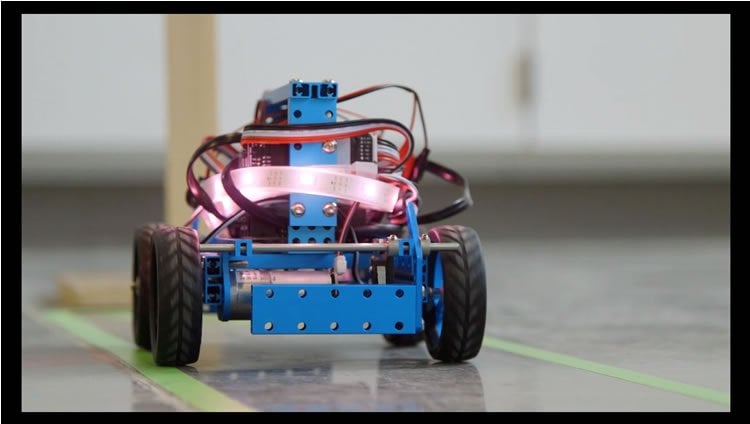Forget the Vulcan mind-meld of the Star Trek generation — as far as mind control techniques go, bacteria is the next frontier.
In a paper published in Scientific Reports, a Virginia Tech scientist used a mathematical model to demonstrate that bacteria can control the behavior of an inanimate device like a robot.
“Basically we were trying to find out from the mathematical model if we could build a living microbiome on a nonliving host and control the host through the microbiome,” said Warren Ruder, an assistant professor of biological systems engineering in both the College of Agriculture and Life Sciences and the College of Engineering.
“We found that robots may indeed be able to function with a bacterial brain,” he said.
For future experiments, Ruder is building real-world robots that will have the ability to read bacterial gene expression levels in E. coli using miniature fluorescent microscopes. The robots will respond to bacteria he will engineer in his lab.
On a broad scale, understanding the biochemical sensing between organisms could have far reaching implications in ecology, biology, and robotics.
In agriculture, bacteria-robot model systems could enable robust studies that explore the interactions between soil bacteria and livestock. In healthcare, further understanding of bacteria’s role in controlling gut physiology could lead to bacteria-based prescriptions to treat mental and physical illnesses. Ruder also envisions droids that could execute tasks such as deploying bacteria to remediate oil spills.
The findings also add to the ever-growing body of research about bacteria in the human body that are thought to regulate health and mood, and especially the theory that bacteria also affect behavior.
The study was inspired by real-world experiments where the mating behavior of fruit flies was manipulated using bacteria, as well as mice that exhibited signs of lower stress when implanted with probiotics.

Ruder’s approach revealed unique decision-making behavior by a bacteria-robot system by coupling and computationally simulating widely accepted equations that describe three distinct elements: engineered gene circuits in E. coli, microfluid bioreactors, and robot movement.
The bacteria in the mathematical experiment exhibited their genetic circuitry by either turning green or red, according to what they ate. In the mathematical model, the theoretical robot was equipped with sensors and a miniature microscope to measure the color of bacteria telling it where and how fast to go depending upon the pigment and intensity of color.
The model also revealed higher order functions in a surprising way. In one instance, as the bacteria were directing the robot toward more food, the robot paused before quickly making its final approach — a classic predatory behavior of higher order animals that stalk prey.
Ruder’s modeling study also demonstrates that these sorts of biosynthetic experiments could be done in the future with a minimal amount of funds, opening up the field to a much larger pool of researchers.
The Air Force Office of Scientific Research funded the mathematical modeling of gene circuitry in E. coli, and the Virginia Tech Student Engineers’ Council has provided funding to move these models and resulting mobile robots into the classroom as teaching tools.
Ruder conducted his research in collaboration with biomedical engineering doctoral student Keith Heyde, of Wilton, Connecticut, who studies phyto-engineering for biofuel synthesis.
“We hope to help democratize the field of synthetic biology for students and researchers all over the world with this model,” said Ruder. “In the future, rudimentary robots and E. coli that are already commonly used separately in classrooms could be linked with this model to teach students from elementary school through the Ph.D.-level about bacterial relationships with other organisms.”
Source: Amy Loeffler – Virginia Tech
Image Credit: The image is credited to the researchers/Virginia Tech
Video Source: The video is available at the Virginia Tech Vimeo page
Original Research: Full open access research for “Exploring Host-Microbiome Interactions using an in Silico Model of Biomimetic Robots and Engineered Living Cells” by Keith C. Heyde and Warren C. Ruder in Scientific Reports. Published online July 16 2015 doi:10.1038/srep11988
Abstract
Exploring Host-Microbiome Interactions using an in Silico Model of Biomimetic Robots and Engineered Living Cells
The microbiome’s underlying dynamics play an important role in regulating the behavior and health of its host. In order to explore the details of these interactions, we created an in silico model of a living microbiome, engineered with synthetic biology, that interfaces with a biomimetic, robotic host. By analytically modeling and computationally simulating engineered gene networks in these commensal communities, we reproduced complex behaviors in the host. We observed that robot movements depended upon programmed biochemical network dynamics within the microbiome. These results illustrate the model’s potential utility as a tool for exploring inter-kingdom ecological relationships. These systems could impact fields ranging from synthetic biology and ecology to biophysics and medicine.
“Exploring Host-Microbiome Interactions using an in Silico Model of Biomimetic Robots and Engineered Living Cells” by Keith C. Heyde and Warren C. Ruder in Scientific Reports. Published online July 16 2015 doi:10.1038/srep11988






